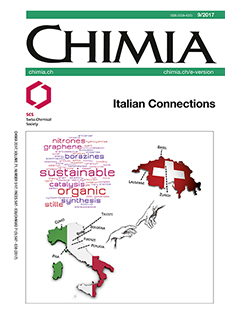Chemical Functionalization of Carbon Nanomaterials: Bridging the Gap between Simple Carriers and Smart (Metal-free) Catalysts
DOI:
https://doi.org/10.2533/chimia.2017.568Keywords:
C–c bond formation, Chemical functionalization, Co2 valorization, Metal-free heterogeneous catalysts, OrrAbstract
The last few years have witnessed a wonderful technological renaissance that boosted the development of carbon-based nanomaterials (CNMs) doped with light heteroelements and featuring hierarchical porous architectures as valuable metal-free catalysts for a number of key industrial transformations. To date, several approaches to their synthesis have been developed, although many of them lack any real control of the final doping and composition. In contrast, chemical functionalization offers a unique and powerful tool to tailor CNMs' chemical and electronic surface properties as a function of their downstream application in catalysis. Different catalytic processes (hydrolysis/esterification/transesterification reactions, C–C bond forming reactions, CO2 derivatization into products of added value and electrochemical oxygen reduction reactions (ORR)) can be conveniently promoted by these materials. In addition, selected examples from this series offer a valuable platform for the in-depth comprehension of the underlying reaction mechanisms. This perspective article offers an overview on the main examples of ad hoc chemically decorated CNMs successfully exploited as metal-free catalysts, highlighting at the same time the importance of the surface chemistry control for the design of more active, metal-free and single-phase heterogeneous catalysts.Downloads
Published
2017-09-27
Issue
Section
Scientific Articles
License
Copyright (c) 2017 Swiss Chemical Society

This work is licensed under a Creative Commons Attribution-NonCommercial 4.0 International License.
How to Cite
[1]
Chimia 2017, 71, 568, DOI: 10.2533/chimia.2017.568.







